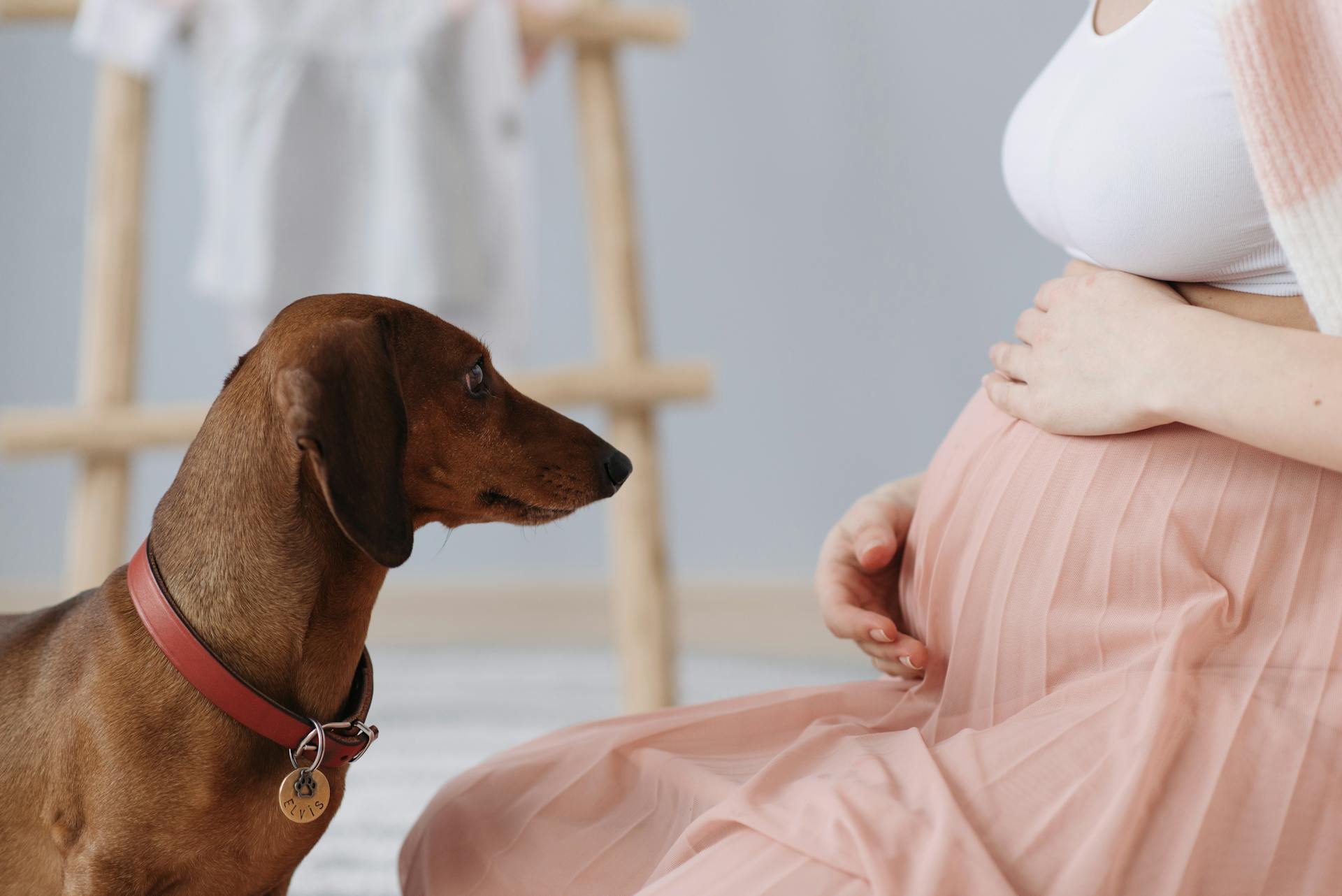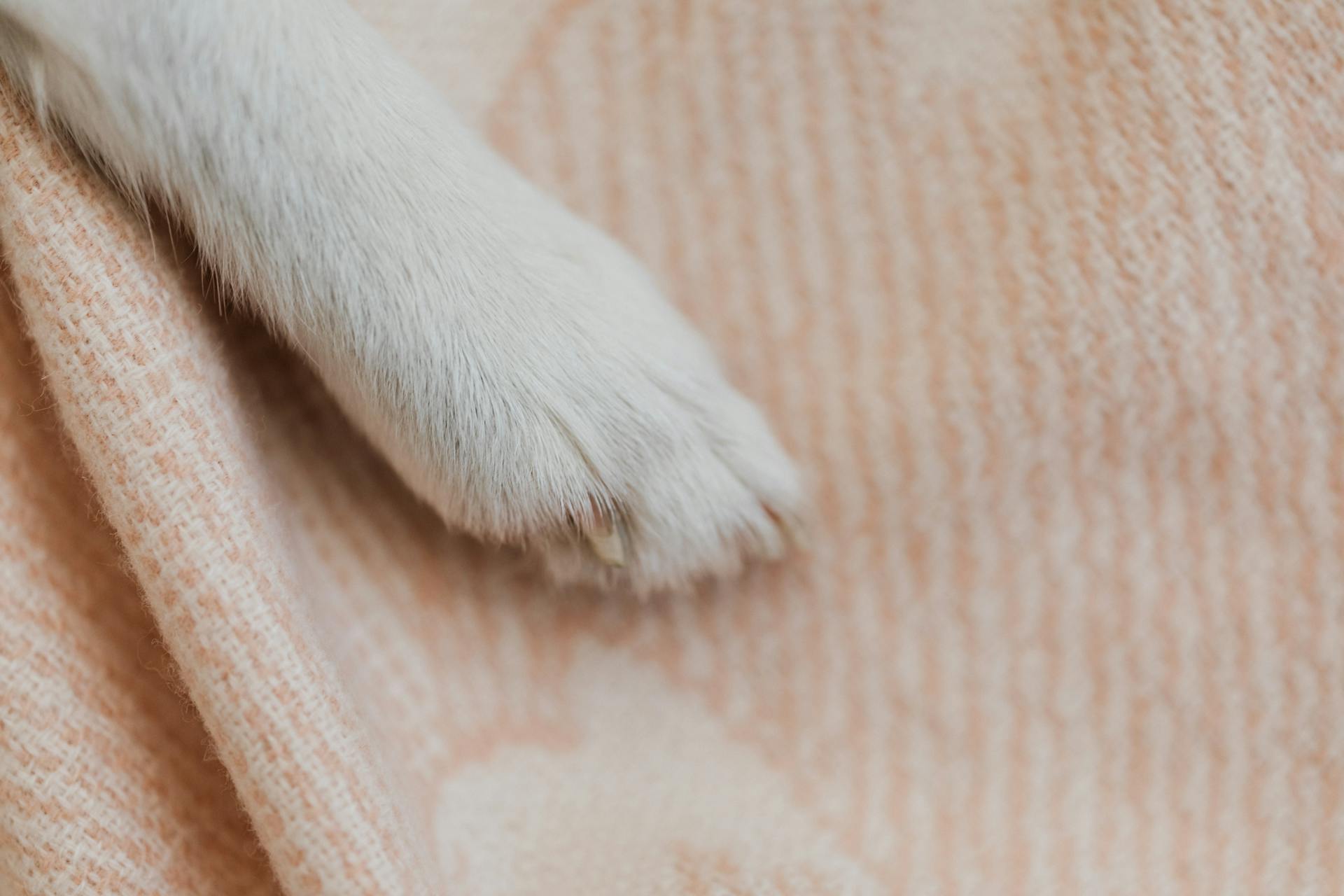
If you've noticed a lump on your dog's stomach, it's normal to feel concerned.
The lump could be a sign of a harmless fatty tumor, also known as a lipoma, which is a common occurrence in dogs.
However, it's essential to have your dog checked by a veterinarian to rule out any serious health issues.
Some lumps can be a sign of more serious conditions, such as mast cell tumors or lymphoma, which require prompt attention.
Your veterinarian will examine the lump and take a sample for further testing to determine its nature.
In some cases, the lump may be a sign of a digestive issue, such as gastrointestinal foreign bodies or inflammatory bowel disease.
Causes of Lumps
While it's not always possible to pinpoint the exact cause of a lump on your dog's stomach, there are some common factors that may contribute to their development.
Lipomas are thought to occur due to a number of factors including diet, genetics, chemicals in the environment, drug interactions and more.
Maintaining your dog's weight at a healthy level may help to prevent lipomas from occurring.
Some lumps can be caused by infections or other underlying conditions.
Skin tags, button tumors, and abscesses are common types of lumps found on puppies.
These lumps are usually non-cancerous, but it's always best to have a veterinarian examine and diagnose any changes to your dog's skin.
In rare cases, a vaccination site swelling can turn into a malignant tumor, so it's essential to contact your vet if a vaccination lump lasts more than a week.
If you're concerned about your pet's health, you should contact a vet to discuss your concerns and determine the best course of action.
Intriguing read: Skin Cancer Lump on Dog
Types of Lumps
Dogs can develop a variety of lumps and bumps on their skin, and it's essential to understand the different types to determine the best course of action.
Some common types of lumps on dogs include lipomas, which are fatty tumors that are usually found on the abdomen and chest. Lipomas are typically soft, mobile, and painless, but they can become bothersome if they interfere with your dog's movement. Other types of lumps include histiocytomas, which are benign skin growths that often occur in dogs under two years old, and sebaceous gland tumors, which are common in older dogs.
For another approach, see: Bull Terrier Skin Problems
Here are some common types of lumps on dogs:
It's essential to have any lump or bump on your dog examined by a veterinarian to determine the best course of action.
Cysts
Cysts are a type of lump that can appear on a dog's skin, and they're often caused by a blockage in a sebaceous gland.
A cyst can appear as a small, fluid-filled sac under the skin, and it may be tender to the touch. They can occur anywhere on a dog's body, but are most commonly found on the face, neck, and chest.
Some cysts are benign, meaning they're not cancerous, but others can be a sign of an underlying infection or other health issue.
Cysts can be diagnosed with a fine needle aspirate, which involves using a thin needle to collect cells from the cyst and examine them under a microscope.
Treatment for cysts usually involves draining the fluid from the cyst and, in some cases, surgically removing the cyst.
Readers also liked: Hard Lump after Dog Bite
Papilloma
Papilloma is a contagious, wart-like growth that usually occurs in and around the mouth of young dogs, but can also appear around the eyes or on other areas of the body in older dogs.

They are caused by a virus that can be spread through direct contact with an infected dog or contaminated items, such as toys or feeding bowls.
Papillomas are small, fleshy, and round with a cauliflower-like texture to the surface.
Many papillomas will dry up and fall off within a few months as the dog's immune system matures.
Severe cases may make eating or swallowing difficult and require treatment by surgical removal, or other methods such as crushing of the warts to stimulate the immune system.
Basal Cell Carcinomas
Basal Cell Carcinomas are flattened or raised growths that appear anywhere on the body of an older dog.
They may spread to surrounding skin, forming new ulcerations.
Basal Cell Carcinomas rarely spread to other organs.
Surgical removal is recommended, including enough skin around the tumor to ensure that no tumor cells remain.
Lymphosarcoma
Lymphosarcoma can look like flaky skin, red patches, raised and ulcerated areas, or lumps deep within the skin.
It's essential to determine which type of lymphosarcoma your dog has early on, as there are two forms that differ in their expected progression and response to treatment.
Lymphosarcoma rarely develops directly on a dog's skin but may be seen as a surface tumor or along with internal tumors.
Treatments for lymphosarcoma include surgical removal, chemotherapy, and radiation, which may be done separately or combined.
These treatments can improve the signs of the disease, but they do not lengthen the dog's life expectancy.
A sample of cells may need to be taken and evaluated under a microscope for a diagnosis.
You might like: Can a Dog's Stomach Acid Dissolve Wood?
Hernia
A hernia is a type of lump that can appear on a dog's abdomen. It occurs when a portion of an abdominal organ protrudes through the abdominal wall.
The most common type of hernia in puppies is an umbilical hernia, which appears on the abdomen in the spot where the umbilical cord was attached.
Expand your knowledge: Lump Dog Spay Incision Hernia
Symptoms of a hernia can vary, but some hernias may cause pain, discomfort, or other symptoms. In severe cases, a hernia can lead to complications such as the puppy's intestines slipping through the opening and becoming twisted or strangled.
If you suspect your puppy has a hernia, it's essential to have them seen by a vet right away. A hernia can be repaired during spaying or neutering, but larger hernias may require immediate surgery.
Here are some common signs of a hernia in dogs:
- A visible lump or bulge on the abdomen
- Pain or discomfort in the abdominal area
- Vomiting or loss of appetite
- Weight loss or lethargy
- Coughing or shortness of breath
If you're unsure about the cause of a lump on your dog's belly, consult with a veterinarian for a proper diagnosis and treatment plan.
Identifying and Assessing Lumps
The first step in understanding what's going on with your dog's lump is to assess its appearance. Take a close look at the lump's color, shape, size, and texture. Does it seem to be fixed to the underlying tissue, or can you move it around? This can be a good indication of whether it's benign or potentially malignant.
The consistency of the lump is also important. Is it soft and squishy, or hard and rigid? A hard, rigid lump can be a sign of malignancy, while a soft bump is usually benign. Take note of whether the lump is movable or fixed, as this can also indicate its nature.
Here are some characteristics to look for:
- Size: Note the size of the lump and whether it's growing or shrinking.
- Color: Is the lump red, swollen, or irritated?
- Texture: Is the bump squishy, or is it hard to the touch?
- Location: Where is the lump located on your dog's body?
- Movability: Can you move the lump around, or is it fixed to the underlying tissue?
- Discharge: Is there any discharge present?
Assess the Visuals
Assessing a lump on your dog's body can be a concerning experience, but taking a closer look can help you determine its significance. It's essential to note the location of the lump, how long it's been there, and any changes you've observed over time.
Taking a series of photographs can be incredibly helpful for your veterinarian to make a diagnosis. This can be as simple as snapping a few pictures with your phone to capture the lump's size, color, and texture.
When assessing the visuals, pay attention to whether the lump is moveable or seems to be fixed to underlying tissue. This can be a crucial detail for your veterinarian to determine the best course of action.
You might want to keep a log to track any changes in the lump, including its size, color, and texture. This can be as simple as noting these details in a notebook or using a mobile app to track your observations.
Here are some key characteristics to look out for when assessing a lump on your dog's stomach:
By paying attention to these details and keeping a log of your observations, you can provide valuable information to your veterinarian and help them make an accurate diagnosis.
Identifying a Lump on My Dog
Identifying a lump on your dog can be a worrying experience, but knowing what to look for can help you determine the best course of action. Consistency is key, so pay attention to whether the lump is movable and pliable or rigid and stiff. If it's hard to the touch, it could signal possible malignancy.
The texture of the lump is also important. If it's extremely firm and rigid but otherwise immovable, it might be fixed. On the other hand, if it's squishy or moves with ease, it could indicate fluid buildup. Soft bumps are usually benign, but it's always best to err on the side of caution and have your vet take a closer look.
Assessing the visuals is also crucial. If the lump is red, swollen, irritated, or oozing, it's a good idea to have your vet take a look. You might have just noticed it when you were rubbing your dog's tummy, but it's always better to be safe than sorry. Take note of any changes in the lump's appearance, and make an appointment with your vet as soon as possible.
Here are some key things to note when assessing the lump:
- Location: Where is the lump located on your dog's body?
- Size: How big is the lump?
- Color: What color is the lump?
- Texture: Is the lump soft, firm, or somewhere in between?
- Movement: Can you move the lump easily, or is it fixed in place?
- Discharge: Is there any discharge present?
By paying attention to these factors, you can get a better understanding of what you're dealing with and make an informed decision about what to do next. Remember, it's always better to err on the side of caution and have your vet take a closer look.
Frequently Asked Questions
Are cancer lumps on dogs hard or soft?
Cancerous lumps on dogs are typically hard and firm to the touch, unlike lipomas which are soft and fatty. If you suspect a lump on your dog, it's essential to have it checked by a veterinarian for proper evaluation and diagnosis.
What is the most common abdominal mass in dogs?
The most common abdominal mass in dogs is a splenic mass, which can be either cancerous or benign. In fact, up to 50% of splenic masses are non-cancerous, making them a significant consideration in canine veterinary medicine.
What does a lipoma lump look like on a dog?
A lipoma lump on a dog is typically a small, soft, and mobile lump under the skin, often covered in hair. It may feel firmer or more attached to the surrounding tissue in some cases.
How to tell the difference between a cancerous lump and a cyst on a dog?
A veterinarian's examination and cell sample analysis are necessary to determine the type and severity of a lump or bump on a dog, as visual inspection alone is not sufficient. Consult a vet for an accurate diagnosis and treatment plan.
Sources
- https://www.petmd.com/dog/symptoms/lumps-bumps-and-cysts-dogs
- https://www.akc.org/expert-advice/health/dog-skin-lumps-bumps/
- https://www.dogster.com/dog-health-care/what-is-the-lump-on-my-dogs-stomach
- https://www.denvervet.com/site/blog/2022/08/31/fatty-tumor-lipoma-dog
- https://dogcare.dailypuppy.com/could-cause-lump-puppys-belly-6268.html
Featured Images: pexels.com


